Change-if you want to understand it, spend some time in a garden! It’s May in our tropical garden, and like every other gardener, I am eager to observe how our garden changes from March to April. But May 2022 might be the time to look back and see how the garden changes year to year. ” It’s May in our South Florida Garden” shows you last year’s garden. Today, I’ll take the same plants and projects and show you how they have changed over the year.
Everybody thinks about change; we can’t help it! And for us gardeners, change is an important concept.
“There is nothing permanent except change.”
-Heraclitus
An early philosopher (540-480 BC), not much is known about Heraclitus. But he is the guy who brought us “you never step twice into the same river”! He believed that change is the given that we need to learn to live with and that we humans ought to get on with it!
Gardeners learn this quickly. The garden is constantly changing; our job is to guide that change and make something beautiful and valuable.
See below for three issues we address every month. Look for
“There ought to be gardens for all months of the year, in which severally,
things of beauty may then be in season.
-Francis Bacon
In our zone 10a garden, Francis Bacon would be in luck! Living much later than Heraclitus (1561-1626), he was a statesman, philosopher, and legal advisor to Elizabeth l. In his lifetime, he would have seen the early arrivals of tropical plants to Europe, but I am not sure he would have been ready for the life of a South Florida gardener. In his time, they built walls around their gardens to keep too much nature out. Now we struggle to invite it in!
I think the tropical plants we have with something in bloom 365 days a year would have amazed him. However, he might not have been prepared for the “bugs never quit”!
It’s May for all of us gardeners. For you, it might be “peak spring” -that burst of renewal- the color and form before the summer. For us in South Florida, May brings the last of the varied vegetables and our final opportunity to prepare for hurricane season. We are staking young trees and changing our “winter annuals” for the hardy ones that can survive the heat, humidity, storms, and the “bugs that never quit.”
Here are some of the issues introduced last May and how they progress.
Last May, I published photos of our vanilla orchid plants blooming on palm trees in the backyard. This year we have added a trellis of vanilla orchid plants.
Why? We love the beautiful pale green flower and the trailing vine form. Can I get clever enough to grow a vanilla pod? We’ll see. Vanilla is possibly the most popular of flavors, and it’s undoubtedly the most expensive! So much so that with very few sources of organic supply, only 1% of all the vanilla we eat today is natural. The other 99% is made in a lab.
Here in South Florida, our farmers are adapting to grow the vanilla orchid, and hobby gardeners are raising them too. Our Master Gardener group runs a multi-month Garden Seminar every spring, and we are seeing a lot of interest in growing this orchid variety.
Our state University is researching efficient ways for local growers to produce vanilla. This one crop alone could save many of our family farms. We have high hopes and are proud that the County Extension service, where we Master Gardeners volunteer, is part of the project. Among us hobbyist orchid growers, the vanilla orchid is increasing in popularity. It is an asset in our trees.
This summary discusses the University of Florida’s Tropical Research and Education Center (TREC) in South Florida. It includes some good growing advice.
My vanilla orchid started as a gift. A piece of thick, smooth green vine is nothing like any other orchid we grow! We grow orchids on the walls of the pool enclosure. When they finish their long bloom periods, we attach them to trees where they rebloom for years.
For this purpose, we commonly use Dendrobiums. Cattleya and Phalaenopsis orchids. If you have trouble with orchids, the Phalaenopsis is accessible and adaptable. Try them; they are an excellent way to build confidence.
The vanilla gift was a piece about 2 feet long. I dug a shallow trench in the soil where I very lightly buried about half the orchid piece and propped the rest up the palm’s trunk. I watered and fertilized, and that was that!
Our local orchid club gives a good course on orchid varieties and care. If you took a similar instruction, you were probably told to feed your orchids with an orchid or general bloom product “weekly-weakly.” This means that a diluted solution in water is applied about every seven days. If this works for your other orchids, it also works well for the vanilla orchids.
The vanilla orchid grows up the palm trees, adding a green touch to the trunks, and up high, you see the rows of spring blossoms. And that was my error. They look lovely blooming on the palms, but they have no natural pollinator in our area. So to raise a vanilla pod, I have an uphill climb to pollinate them in the one day possible!
Vanilla orchids were native to Mexico and were valued by the Aztecs, then Hernando Cortez brought them to Spain. What could not be transported was the bee that pollinated them. If you buy a vanilla pod today, it was probably grown in Madagascar and pollinated by hand. Now we understand the price!
The trellis is roughly my height, so I can feed and care for them quickly. The frame is one we bought online from Gardener’s Supply. I wonder what those Vermonters would think of the use we put it to!
Yes, many people do. Use rich orchid soil in your container and include a trellis. You will need bright indirect sun and your most humid indoor location. This is a popular hobby, and you should find many articles online, cuttings and plants for sale, and a good number of videos.
Here on the southernmost gulf coast, we live in two distinct seasons; mild and dry, wet and humid. Change is in the air. The garden is about knowing what we can control and what we need to adjust to. The time to adapt and react is coming soon.
I write “This Month In The South Florida Garden” because every season is essential for all of us gardeners. We compare it to the months before and after and to last year. To be a gardener, I think you must love living close to the earth.
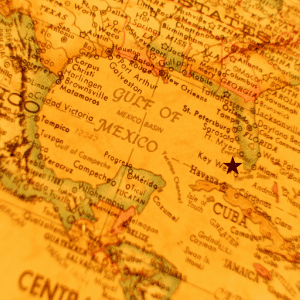
We garden near the red star on this map. Technically, we are in North America, but our living and growing location is nothing like the rest of the continent.
(The star is pointing to our garden!)
We are northern transplants; every time I write down what happens each month, I wish somebody had done it for me. We have gardened in a few different places, but the transition to Florida gardening was the most challenging.
If you don’t keep a journal, try it out. It improves your memory.
Spring is always shorter than we hope. The longer we garden, wherever we garden, the more we all recognize the subsets of spring.
The difference between our various temperate climate gardens and our three Florida gardens is one of degree. Everywhere, we gardeners expect summer to be sultry, buggy, and sometimes stormy. In Florida, we square that fact! Our sun is intense, our heat exhausting, and our humidity extreme! We are a hurricane epicenter. This month we are staking our young trees, changing annuals, and generally preparing for an onslaught of pests, diseases, heat, and wind/rain attacks.
If you are prepared for the season, it’s doable, and you will have lots of time for the pool and the beach!
‘And after winter foloweth grene May.“
-Geoffrey Chaucer, ‘Troilus & Criseyde‘
Chaucer wrote this love poem (and Shakespeare drew on it). It’s about star-crossed lovers whose lives are complicated by war and politics. (This was the Trojan War; you know how well that went for everybody.) What’s new, you say!
To me, Chaucer’s line talks about the fact that we humans can intervene all we want. Love, war; we get involved in a lot of things. But the seasons are inevitable! They are constantly changing; they keep on moving and what we need to do is keep up! May is the month that, for you in cold climates, really starts the spring. You plant, then you watch the beauty of the new shoots arising.
“What dreadful hot weather we have!
It keeps me in a continual state of inelegance.”
-Jane Austen
In South Florida’s climate, the earth never stops pushing up growth. (And the bugs never sleep!) But the change is just as dramatic. Our long season of mixed fresh vegetables and temperate climate blooms is ending.
We will still have lush and colorful flowers and foliage; however, they will differ. But wait till you see the blooming ginger! But it’s true, even in our best garden hats, we can become inelegant!
How often have the neighbors stopped by for a look at the garden (and to share a cutting), and as they leave, I think about the fact that I am wearing sweat-covered clothing, white blobs of sunblock, and the ratty old Tula hat! (I try not to think about it.)
All gardeners know that some of our “brilliant” ideas are more brilliant than others! The five gardenia trees planted over time from the front porch and down the east side of the house were brilliant ideas. The blooms have been here for weeks, and coffee on the patio is like a vacation. I can bring a single color inside, which perfumes the whole room.
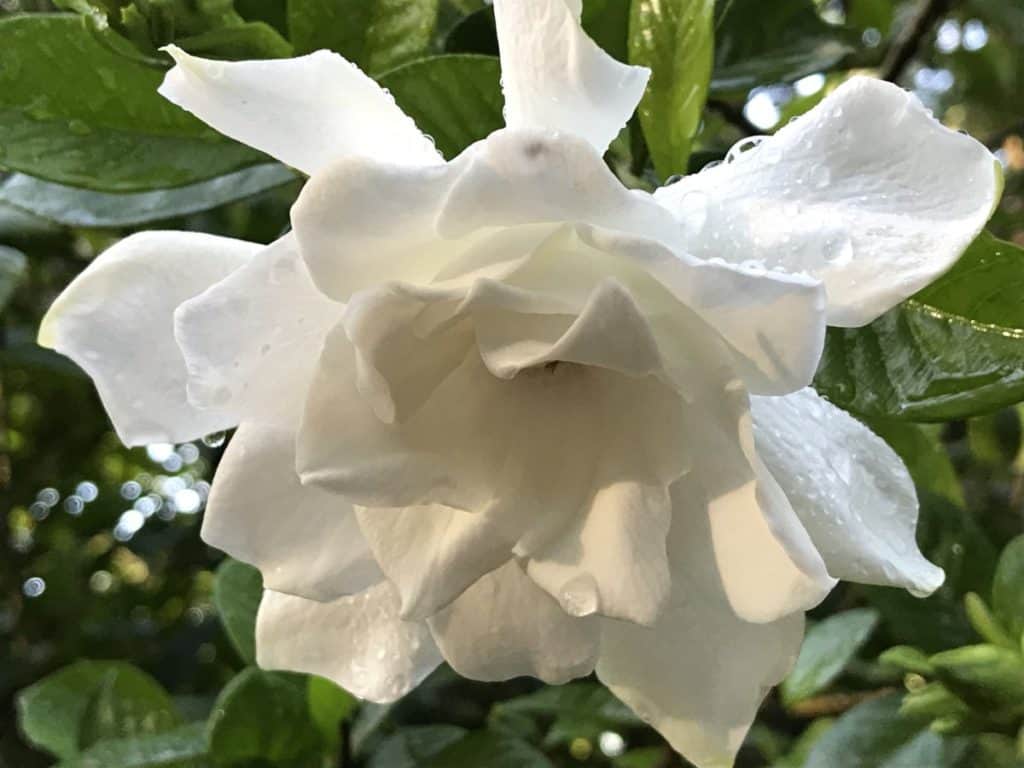
This piece covers what we have learned about caring for the Gardenia. I wish we had more!
Well, we’ve got plenty of wildlife, and not all of them showed up with an engraved invitation! The garden started; bare, green, bird, and devoid of pollinators!
Change in this garden began with a 12′ long x 4′ wide “pollinator bed, ” and it never looked back. Butterflies arrived first, and now hummingbirds abound. The little game camera records nocturnal visitors, deer, rabbits, and a giant paw print, placed bang between the caladiums! Located on the edge of a preserve, we see bears and panthers.
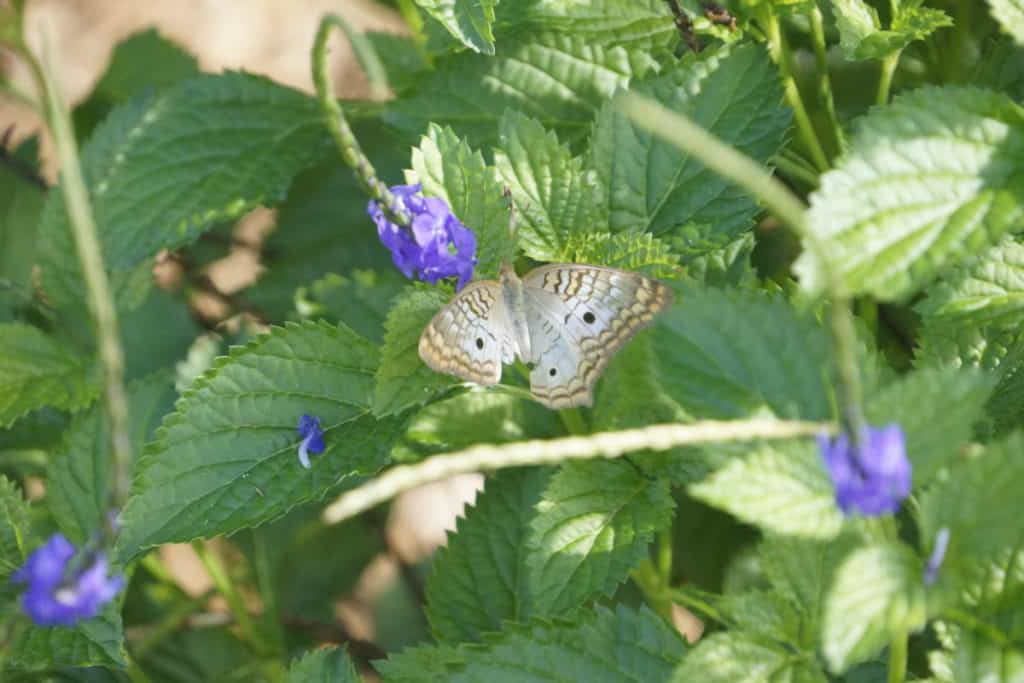
If you would like to attract some butterflies, here is some help.
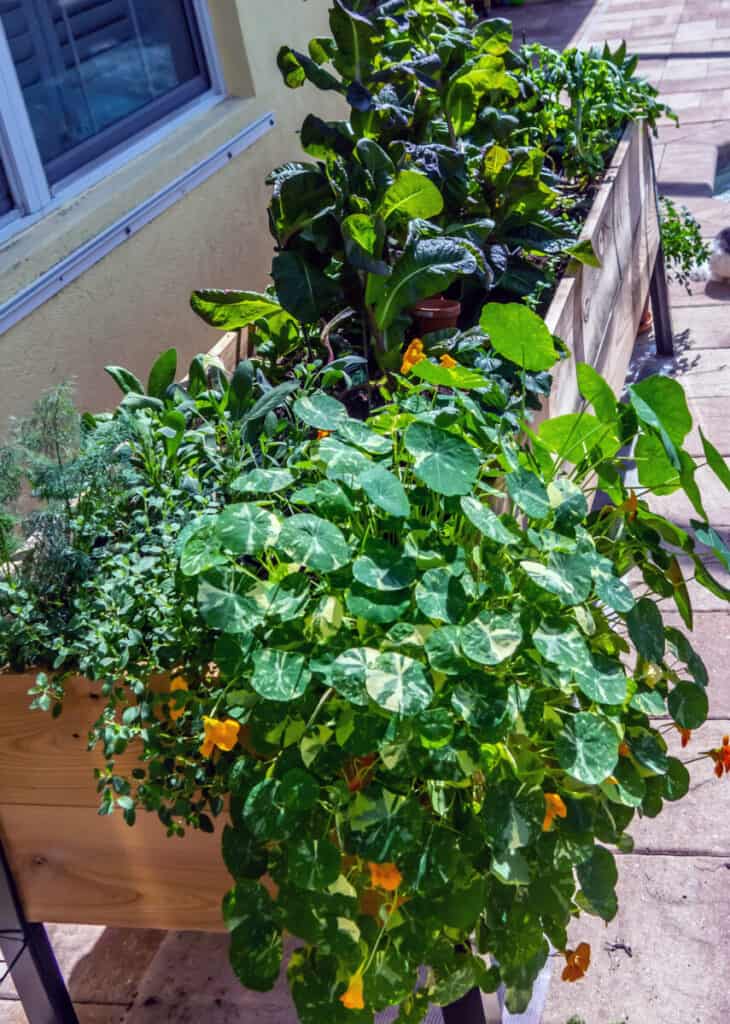
This is a waist-high elevated garden bed. It holds a remarkable number of plants. From left, those in front are a low-growing dill, oregano, and a trailing nasturtium. Float those lush blossoms on a chilled soup!
It is a tiny garden but perfect for busy families, people with little space, and anyone not great at bending.
Here is a little summary of how it’s going for us. “How to Grow Vegetables When You Have No Space.”
Last summer, the heavy rains kept the soil far too wet. This year we are adding an arched trellis. We will grow some vines over it, shade the edibles, and slow down the water.
I’ll tell you how it grows.
The herbs are still potent, but some will not like the humidity. I find myself adding in more of the tropical herbs. Cuban Oregano is solid but tasty and grows all year (Rabbits hate it!) We are adding Mexican Tarragon for the humid months. Tarragon is unique, and vinaigrette is such an easy way to add it to your meals that the Tarragon article has two different vinaigrette recipes.
A dwarf variety of dill works well in the elevated bed. Loads of feathery foliage, just shorter. It is called Fernleaf and is only 18″ tall; another Delikat is 10-14″ in height. If you would like to plant some, here is more information. “How to be Successful Growing Dill for the Kitchen.”
We are eating crisp and tangy chives and rosemary. The first big pot of biannual parsley is in its second year, so we ahave addeda new one. We like to say that if you cook like a gardener or garden like a cook, chive is the plant for you! We are also eating summer savory, peppery, and piquant in flavor.
Would you like to grow some herbs for your kitchen? Try this: “Aromatic Culinary Herbs.”
| Category | Planting Idea | Resources for You |
| Annuals for Color (these perform well in hot weather) | Wax begonia, salvia, coleus, Torena | https://www.hgtv.com/outdoors/flowers-and-plants/13-heat-proof-annuals-pictures |
| Bulbs | Canna lily, tropical lilies, clivia, Aztec, amazon | http://edis.ifas.ufl.edu/topic_bulbous_flowers |
| Vegetables (The summer vegetable list is shorter) | Sweet potato, tropical spinach, Malibar variety, everglades tomato, watermelon, black-eyed peas. Peppers and eggplant may continue on. | https://sfyl.ifas.ufl.edu/lawn-and-garden/summer-vegetables-in-florida/ |
| Herbs (These are successful in heat). | Basil, Cuban oregano, ginger, cumin, Mexican tarragon, summer savory, rand osemary. Depending on weather and care, the others may remain successful also | https://www.flgardening.com/easiest-herbs-to-grow-in-florida/ |
We are eating “crimson giant” and “French breakfast,” they have a little spring to their flavor, mildly peppery and fresh. Try some in salads. I am planting the seeds in succession, but I still don’t keep up with our desires for the little things. A French chef I rea s s they were the after-school snack when she was a kid. F: freshead, farm-made butter, and radishes. We should try it!
This is not a complete list bu,t it covers problems we most complain about.
| Problem or Task | What To Do | Resources For You |
| Pests | Thrips, mites & Scale are most active now | : http://edis.ifas.ufl.edu/topic_landscape_pests |
| Plants to Watch-Gardenia & Ixora | Yellowing of new growth indicates a micronutrient deficiency | http://edis.ifas.ufl.edu/topic_nutrient_deficiencies_landscape_plants |
| Oleander | Oleander caterpillar, look for chewed leaves | https://edis.ifas.ufl.edu/topic_oleander_ipmhttps://edis.ifas.ufl.edu/topic_oleander_ipm |
| Lawn Maintenance | Mow at recommended summer height, chinch bugs | https://edis.ifas.ufl.edu/topic_turf_pest_insectshttps://edis.ifas.ufl.edu/topic_turf_pest_insects |
| Lawn Diseases | Follow cultural practices to avoid disease | https://edis.ifas.ufl.edu/topic_turf_diseases |
| Tomatoes | A time for pests, diseases, and nutritional disorders | https://edis.ifas.ufl.edu/topic_tomato_gardening |
| Tree Care | Prepare for hurricane season, use only ISA Certified arborists | http://edis.ifas.ufl.edu/topic_tree_pruning |
Meteorologists tell us that the rains should start about May 15th and that hurricane season starts next month. Some weather experts would like to begin hurricane season in mid-May! Hurricane danger tends to increase as the summer progresses, but the wise farmer plans ahf you have (or would like to have) a Florida garden he,re is what we do.
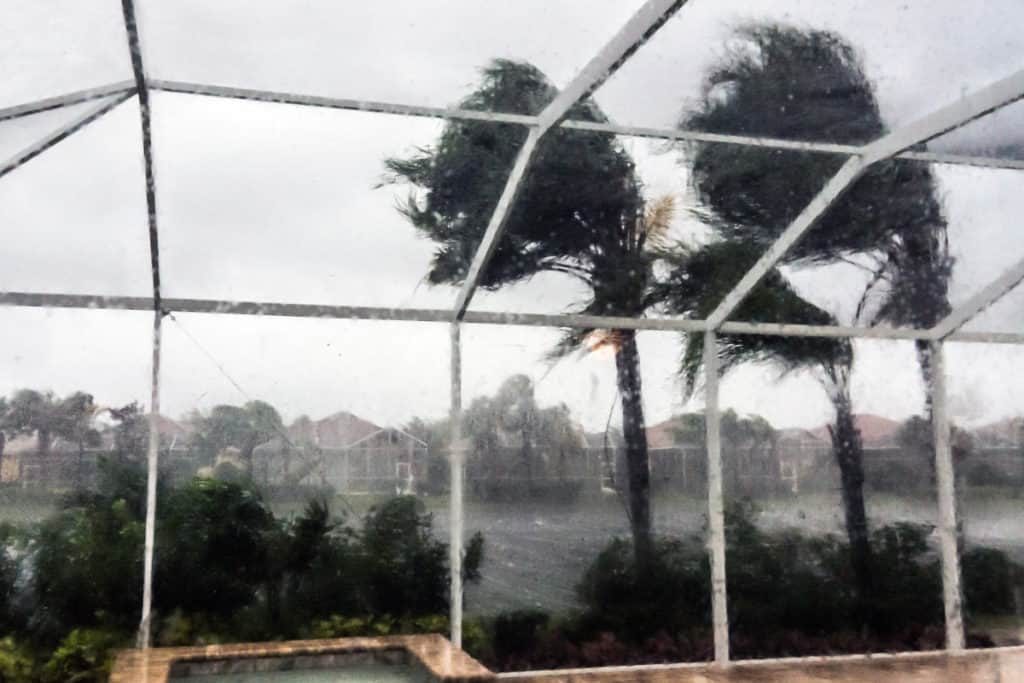
And this is why we prepare ahead of time! Whitecaps on the pond!
We plant our small plots all year round. Sun solarization, i a chemical-free, way to manage pests in the unplanted parts of your garden. Here is a “how-to” from the University of Florida.
I wish more gardeners paid attention to this! Here is why:
Here is what we do to save our skins. It’s like getting dressed and grabbing the garden tools. You need to do it without thinking.
Shakespeare said, “As full of spirit as the month of May”. Wherever you garden you may be early or late in your season, but it is spring, and the gardens are all blooming. Just don’t forget that the bugs won’t sleep this month!
So go forward with that shovel and conquer the garden. What’s next on your agenda?
Here is my own piece on “Latin for Gardeners (How to read and remember plant names”
Happy digging in your garden this month!

Sign up for my newsletter and download my complete guide to a year-round hurricane-ready garden. It’s the plan designed by two Master Gardeners in the Hurricane-prone tropics!